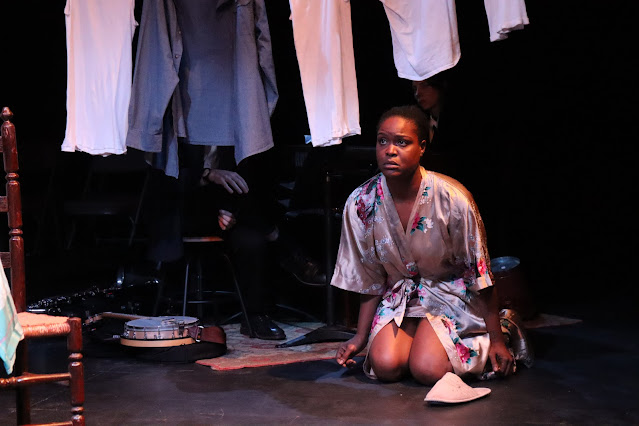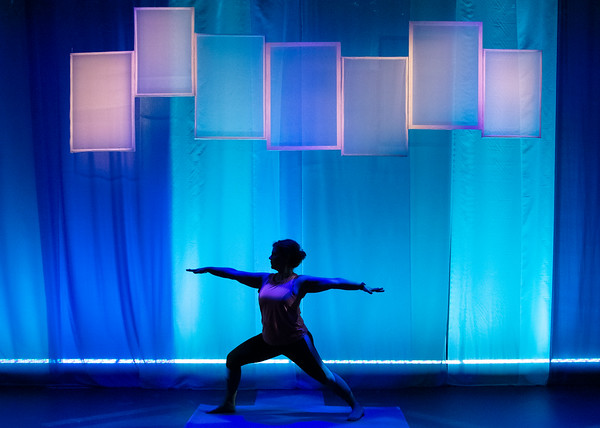Monstress
Book and Lyrics by Emily Kitchens
Music by Ben Quinn and Titus Tompkins
Directed by Hondo Weiss-Richmond
154 Christopher Street, Manhattan, NYC
October 21-November 5, 2022
 |
The Cump'ny of Monstress. Photo by Al Foote III |
Hunger & Thirst Theatre’s new production,
Monstress, may not be the first to reimagine Greek mythology with a feminist slant, but it must be the first to do so as a bluegrass-fueled Southern gathering.
Monstress presents a series of song-studded stories, along with some standalone musical interludes, set in periods ranging from the murky beginnings of creation to the present day but all focused on female monsters. In the production's retellings of these classical stories, cultural traditions separated by continents and millennia harmonize as bewitchingly as do the performers' voices.
 |
| Philip Estrera as Catch with Allison Kelly, Adam Boggs McDonald, and Rheanna Atendido as The Sirens in Monstress. Photo by Al Foote III |
The opening song "Carousel," in acting as a sort of prologue, broaches the persistence of grief as a theme, and the melancholy tinge never entirely disappears, with other songs, for instance, invoking the passage of time and the monstresses themselves often misapprehended at best. At the same time, Monstress is liberally leavened with humor, even in its darker segments, and the ultimate takeaway, as suggested in the closing song, "Look Up," from these ancient yet timely tales is less despair than resilience: they are reminders of the past, like the tattoo mentioned in "Carousel," that also point a way forward. The first segment, which makes appropriately excellent use of darkness, highlights Mother Nyx, night personified, as the fearfully powerful progenitor of all things. The next story concerns another mother, Echidna, the mother of all monsters, and her lover, inhabited in impressively physical performances by Jianzi Colón-Soto and Titus Tompkins, respectively. Echidna has some news for her lover when he visits her cave in search of carnal union, and it ignites a disagreement that changes the dynamics of their relationship in a way that clearly maps onto sexual and reproductive issues that remain pressing today. We also hear from the Sirens (Allison Kelly, Adam Boggs McDonald, and Rheanna Atendido) a very different explanation for all those drownings than we are used to when a man named Catch (Philip Estrera) stumbles upon them while making his way west to California and his one true love in the 1860s; and we drop in on the front porch of another trio, the Graeae (Olivia Billings, Rheanna Atendido, and Jianzi Colón-Soto), or gray ones, who share one eye among them. As a historically significant catastrophe approaches, these sisters give vent to resentment of an existence spent sequestering themselves from the world because they are "too ugly to be loved." In a segment that throws dominant constructions and perceptions of beauty and heroism into question, Phix (Natalie Hegg), a present-day version of the Sphinx, is regarded by her community as a witch and blamed for its problems with poverty and drug addiction. Ed (Olivia Billings), though, is convinced that he is the one who finally has this answer to Phix. Medusa (Rheanna Atendido, who wrings real pathos from the part of a severed head in a bag) is seen not as a problem but as a tool by Perry (Jordan Kaplan, coating Perry's patriarchal privilege in a façade of genial fellowship) in the final segment before "Look Up." Perry's discounting of Medusa's past and agency, as well as the promise that he has made to her (head) in service of her instrumentalization might be seen as an oblique echo of the earlier story of Echidna, forming one, memorable thematic bookend.
 |
| Olivia Billings, Rheanna Atendido, and Jianzi Colón-Soto as The Grey in Monstress. Photo by Al Foote III |
When Medusa turns someone to stone, it involves, fittingly enough for a musical, her singing to him, which gives transformation weight in drawing it out and allowing us to witness the gradual process of the afflicted person losing control of his body. This is not the only striking creative choice in the production, and it also contains some genuinely surprising moments, even if you are intimately familiar with Greek mythology. The performance space is transformed for the various stories and interstitial numbers primarily using some risers and unfussy hangings, contributing to a homespun feel that suits the conceit of a group assembling for storytelling and song. The cast–or Cump’ny, in the show's parlance–performs all of the music live, sometimes in intimate proximity to the audience, intensifying that congenial atmosphere. The music itself begs for a cast recording and ranges from uptempo to haunting to bluesy.
The figure of the monster represents a disrupter of categories; and the monstresses here perform that function in areas from history as an endless repetition of male-authored narratives to the system of gender expectations itself.
Monstress proposes that we could all learn something from them.
-John R. Ziegler and Leah Richards






Comments
Post a Comment